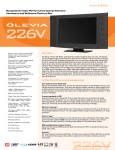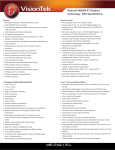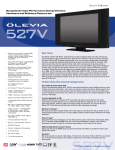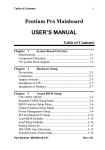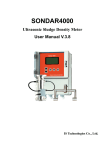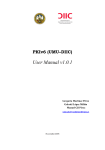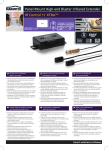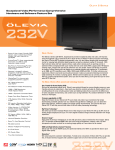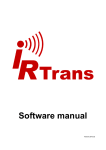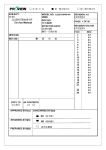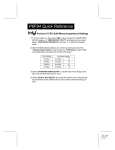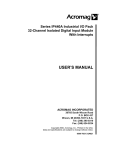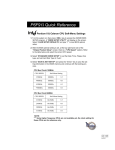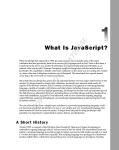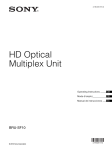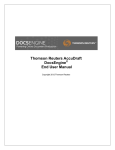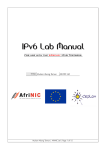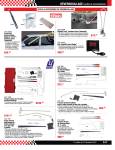Download "user manual"
Transcript
Title: Document Version: Deliverable D4.3 Set Top Box HW and SW Specification Project Number: Project Acronym: IST-2001-37613 Contractual Delivery Date: Project Title: 6POWER IPv6, QoS & Power Line Integration Actual Delivery Date: 31/03/2003 * Type: ** Security Class: 1.2 Deliverable Type* - Security**: 23/06/2003 R – PU P - Prototype, R - Report, D - Demonstrator, O - Other PU- Public, PP – Restricted to other programme participants (including the Commission), RE – Restricted to a group defined by the consortium (including the Commission), CO – Confidential, only for members of the consortium (including the Commission) Responsible and Editor/Author: Organization: Jean-Mickaël Guérin Contributing WP: 6WIND WP4 Authors (organizations): Jordi Palet (Consulintel), David Leslie (Pace). Abstract: This document outlines the hardware and software specifications for the IPv6 version of the IP440PAL Set Top Box product, which Pace is developing under the 6POWER project. Keywords: Hardware, Network, Stack Software, Video Stream. 6POWER Consortium IST-2001-37613 6POWER D4.3: Set Top Box HW and SW Specification Revision History The following table describes the main changes done in this document since its creation. Revision Date Description Author (Organization) v1.0 11/03/2003 Document creation Jean-Mickaël Guérin (6WIND) v1.1 19/06/2003 First full draft of complete document David Leslie (Pace) v1.2 23/06/2003 Final review Jordi Palet (Consulintel) 23/06/2003 – v1.2 Page 2 of 24 IST-2001-37613 6POWER D4.3: Set Top Box HW and SW Specification Executive Summary The IP440PAL is a Set Top Box designed for use in a consumer environment and able to deliver a range of video based consumer services. Within the 6POWER group Pace is involved to convert the product to provide typical video services using IPv6 network protocols rather than the current IPv4. This section describes the overall Hardware and Software specification of the unit together with some information on how the software is being upgraded to operate with IPv6 networks. During the later stages of the project it is intended to demonstrate live TV and video on demand operating over IPv6 networks. At this stage the specifications below are intended to assist other 6POWER partners to understand the integration and demonstration requirements and capabilities of the STB product concerned. We would expect to redraft this specification before completion of the Pace works in the project, so as to reflect the IPv6 product and capabilities generated under this activity. 23/06/2003 – v1.2 Page 3 of 24 IST-2001-37613 6POWER D4.3: Set Top Box HW and SW Specification Table of Contents 1. Introduction ........................................................................................................................7 2. Hardware Specification ......................................................................................................8 2.1 Mechanical Characteristics ..........................................................................................8 2.2 Overall Configuration ...................................................................................................9 2.3 Core Processors..............................................................................................................9 2.3.1 ATI Xilleon 220.......................................................................................................9 2.3.2 Media Processor ....................................................................................................10 2.3.3 Media Subsystem Features ....................................................................................11 2.4 Memory Architecture..................................................................................................11 2.5 Power Supply ...............................................................................................................11 2.6 Hardware Interfaces....................................................................................................11 2.6.1 RF Interfaces Back Panel ......................................................................................11 2.5.1 TV SCART Connectors.........................................................................................12 2.5.2 Video and Audio Connectors (Back Panel)...........................................................12 2.5.3 Smart Card Reader.................................................................................................12 2.5.4 10/100BaseT Ethernet ...........................................................................................12 2.5.5 RS232 Serial Port (Test Task) ...............................................................................12 2.5.6 USB Port................................................................................................................12 2.5.7 Remote Control and LEDs ....................................................................................12 2.6 Hardware Performance ..............................................................................................13 2.6.1 Safety Requirements..............................................................................................13 2.6.2 Reliability Requirements .......................................................................................13 2.6.3 Lightning and Power-spike Protection ..................................................................13 3. Software Specification ......................................................................................................14 3.1 Software Architecture .................................................................................................14 3.2 Network Stack..............................................................................................................14 3.3 Control Software..........................................................................................................14 3.4 Video Control and Graphics.......................................................................................16 3.5 Browser.........................................................................................................................17 3.6 Drivers ..........................................................................................................................18 3.7 Software Development Kit..........................................................................................18 4. Summary and Conclusions...............................................................................................19 5. References .........................................................................................................................20 6. Appendix 1: Acronyms and Abbreviations ......................................................................21 7. Appendix 2: IP440 Specification......................................................................................23 7.1 Service Capability........................................................................................................23 7.2 Main Functions ............................................................................................................23 23/06/2003 – v1.2 Page 4 of 24 IST-2001-37613 6POWER D4.3: Set Top Box HW and SW Specification 7.3 Additional Features .....................................................................................................23 7.4 Connectivity .................................................................................................................24 23/06/2003 – v1.2 Page 5 of 24 IST-2001-37613 6POWER D4.3: Set Top Box HW and SW Specification Table of Figures Figure 2-1: Figure 2-2: Figure 2-3: Figure 2-4: Figure 2-5: Figure 3-1: Figure 7-1: 23/06/2003 – v1.2 Summary of the STB............................................................................................... 8 STB Block Diagram................................................................................................. 9 ATI Xilleon 220 Features....................................................................................... 10 Media Processor Features ................................................................................... 10 Media Processor Features ................................................................................... 11 System Architecture ............................................................................................. 16 IP440 Picture.......................................................................................................... 23 Page 6 of 24 IST-2001-37613 1. 6POWER D4.3: Set Top Box HW and SW Specification INTRODUCTION WP4 aims at designing and developing the devices able to support a large IPv6 deployment over PLC. These developments include the Head End, the Home Gateway, a Set-Top-Box and some adaptations for end devices. Deliverable D4.3 focus on hardware and software specification of the Set Top Box. The Set Top Box (STB) is the equipment that brings IP services to the Home, focusing on the TV service. The device has been designed based on two core silicon processors supported by the Linux operating system, with internal communication carried out using a PCI bus. The main processor is an application specific integrated circuit designed to carry out all core set-top-box functions within a single 'chip'. This is supported by a digital signal-processing unit, a very high performing processor that carry out media decoding (with the exception of MPEG-1 and MPEG2 video which is carried out by the central processor) by executing software based decode algorithms. Below is a list that describes some of the services supported by this digital set-top-box. Digital TV (Live TV). Video On Demand. Web Browsing. Digital Music Services. E-Commerce. Video on Demand. Digital Music services. Gaming. Rich Electronic Programme Guide based customer experience. PC Data communications. Server based Applications. The core of the Set Top Box has become available over the first months of the project and is now available for conversion to provide a version suitable for use over IPv6 networks. 23/06/2003 – v1.2 Page 7 of 24 IST-2001-37613 2. 6POWER D4.3: Set Top Box HW and SW Specification HARDWARE SPECIFICATION This section describes the IP440PAL model hardware including mechanical characteristics and the various hardware subsystems. Note that similar models also exist including IP500PAL and IP420NT, each of which contain most of the facilities described below. These models may also be used within the 6POWER to meet particular requirements. 2.1 Mechanical Characteristics The unit is housed in a 3-part cabinet with plastic front and metal external parts on all five other faces. The overall dimensions (width) x (height) x (depth) are as (305) x (65) x (220) mm. The cabinet is colored light silver grey for use in a consumer environment associated to the household TV set. The product may be used in association with a number of IP gateways into the home. In particular it can be used connected to an ADSL modem, a VDSL modem or importantly for the 6POWER Project used with a Power Line Modem. A summary of the STB is depicted in the following table: Front Buttons - 1 standby (Red/green LED) IR input capability for keyboard, mouse (type RCMM) and RCU (typ. RC5) Rear Mains power 2-pin connector RF input RF output USB Connector (may be used with mouse and USB keyboard) Smart card slot Reset button 2 SCART connectors (European model) One triple Phono connector for AV out SP/DIF (Phono) RJ45 socket for Ethernet NIC connection Test task (As TWC 3-pin HDR behind metal flap) Handset IR Remote Handset with TV control capability (most brands) Additional Items Included in Carton 1.8m Mains lead (black) UK or European RF cable SCART cable Software licence sheet Documentation and Software User manual, Installer manual and other information is held on a secure web site controlled by Pace. For details of how to obtain the right to access this information, contact [email protected]. Figure 2-1: Summary of the STB The secure web site mention in the documentation area also contains server and client side software, which is available to, authorized users only. There are various possible mechanisms for installing this software. 23/06/2003 – v1.2 Page 8 of 24 IST-2001-37613 6POWER D4.3: Set Top Box HW and SW Specification Normally as far as the 6POWER is concerned we anticipate to install the main STB operating software in the STB flash memory; to install any specific software on a boot server at the head end, and to use the boot server to upgrade the main STB software for any specific 6POWER software requirements. The following sections detail the remaining overall requirements IP440PAL AJL 12/02/03 Smartcard 1 *FOR X225* 128Mb NAND FLASH RJ45 & Magnetics Primary CVBS, RGB AKM4351 Audio DAC A I2S RAGE HDTV2 MPEG Decoder (X220 or X225 or X215) PCI dev. 2 Davicom Ethernet 1 PCI Primary Audio L/R Audio & Video Mux Secondary CVBS Y/C AKM4351 Audio DAC B I2S 3V3 PCI Expansion 1 Primary Audio/Video Primary Audio/Video Primary Audio (Secondary Output) L/R PCI dev. 3 Primary Audio/Video CCIR 656 I2S PCI dev. 1 SP/DIF 3.5mm Stereo Jack SERIAL MAP-BSP USB USB 1.1 I/F 2Mx64 133Mhz SDRAM +5V Front panel switches Rear USB Connector Power switch RCMM/RC5 PIC Microcomputer IR RX Figure 2-2: 2.2 Overall Configuration 2.3 Core Processors STB Block Diagram The IP400 product family will contain two media processors, the ATI Xilleon 220 and the Equator Technologies MAP-CA (optional). The next few sub-sections describe the main features and interfaces of each. 2.3.1 ATI Xilleon 220 This component includes a core MIPS processor together with a number of other elements to provide many of the elements of a Set Top Box on a single Integrated Circuit. The main elements are depicted in the following table. CPU Features 23/06/2003 – v1.2 280 MHz MIPS based core running in Solo mode. EJTAG interface Programmable power management features Virtual memory management unit Page 9 of 24 TV SCART 3x PHONO 128Mb NAND FLASH VCR SCART 4Mb NOR FLASH RF Modulator 16/8/4Mx32 133Mhz SDRAM PHONO 16/8/4Mx32 133Mhz SDRAM IST-2001-37613 6POWER D4.3: Set Top Box HW and SW Specification Media Subsystem Features Dual HD MPEG-2 cores Supported audio decoding formats include AC3 and MPEG-2 audio. Support for external audio DSPs Four transport demuxes Picture in picture and time shifting Conditional access control for each transport stream 2D/3D graphics core Integrated Peripheral Controllers Standard ATA 100 EIDE interface supporting up to two HDDs USB 1.1 interface, providing control for up to two ports LPC interface Dual UART support IR controller for remote control handsets External Interfaces 32-bit SDRAM interfaces, supporting SDR and DDR Dual TV outs, providing support for PAL, SECAM and NTSC standards Dual ITU-656 interface for analog or external MPEG decoder support Firewire (IEEE 1394A) interface support Three smart card interfaces, two for CA and one for bank cards External peripheral support including PCI bus, ATI Flexbus and I2C Dual I2S, SPDIF and AC-LINK audio ports Figure 2-3: ATI Xilleon 220 Features The ATI chip is a key component of the IP440PAL unit and includes a number of facilities which are not currently utilized but which may be integrated through new Pace software which could be downloaded to the product some time after deployment. An example would be use of the 3D graphics acceleration package, which could be used for PC type computer games or for specific logo applications. The means of preparing these applications would be based on the Software Development Kit (SDK) and tool chain which is available on the secure web site detailed in Section 2.1 above. 2.3.2 Media Processor The IP440PAL includes a high speed Media Processor, the Equator MAP CA broadband signal processor. This processor is specialized in video processing operations and is available to provide the capability of delivering high quality video pictures from a number of different codec’s. CPU Features VLIW processor capable of operating at 1500+ MIPS This VLIW processor consists of four 32-bit ALUs, one hundred and twenty eight 32-bit general purpose registers, thirty-two 1bit predicate registers and eight special 128-bit registers. The VLIW core also contains a number of instruction and data caches, each of which is 32 KB in size. Figure 2-4: Media Processor Features In addition to this, the MAP-CA also consists of four coprocessors. The main features of these are summarized below: 16-bit RISC processor featuring variable length decoding. Supported by data and instruction memory, each of which are 4 KB long. 23/06/2003 – v1.2 Page 10 of 24 IST-2001-37613 6POWER D4.3: Set Top Box HW and SW Specification Video filter with 6 KB line buffer memory, capable of three different tap configurations. Programmable data streamer for sixty four-channel DMA access with 8 KB buffer memory. DES support. 2.3.3 Media Subsystem Features The I/O interfaces are depicted in the following table. I/O Interfaces PCI bus interface IEC958 audio interfaces I2S interfaces Two DVB transport channel interfaces or One DVB compliant transport channel interface and one ITU 601/656 interface or Two ITU 601/656 interfaces or Anyone of the above and one general data port One ITU 601/656 video output or one general data port Display refresh controller with on chip color space conversion, palette table lookup, alpha-blending and hardware cursor I2C interface Flash ROM (EEPROM) interface Figure 2-5: Media Processor Features The Xilleon 220 incorporates support for two I2C buses. Devices connected via the I2C buses include the modulators, front panel PIC, Zoran audio DSP and the A/V MUX chip. 2.4 Memory Architecture The IP440PAL includes 64 Mbytes of DRAM and 16 Mbytes of non-volatile flash memory as the main memory elements. The main flash part is a 16M(16,777,216)x8bit NAND Flash Memory with a spare 512K(524,288)x8bit. Its NAND cell provides the most cost effective solution for the solid-state mass storage market. 2.5 Power Supply The Set top Box will be designed to be energy efficient consuming no more than 15Watts. A switched mode PSU is employed to provide stabilized DC voltages. The power supply is designed to be flexible to provide for variable input voltage between 90 and 265v ac. Input frequency may be between 47 and 63 Hz. Rigorous line surge tests are applied. 2.6 Hardware Interfaces 2.6.1 RF Interfaces Back Panel A UHF Loop though modulator. Functional Specification UHF Modulator (European Only). 23/06/2003 – v1.2 Page 11 of 24 IST-2001-37613 6POWER D4.3: Set Top Box HW and SW Specification The unit can be selected by software to function on TV system I, B/G or L. This unit contains a modulator able to output on channels 21 - 69. It provides an RF output for the video and audio signals produced by the STB. The unit has an Antenna input, which is amplified and looped through to the output whilst the STB is powered. 2.5.1 TV SCART Connectors TV SCART will provide Composite and RGB video out. Audio out will be volume controlled, CVBS status switching on pin 8 will be supported as will RGB status switching on pin 16. VCR SCART will be capable of providing a clean video signal with no on-screen graphics and the audio will not contain any Computer generated sounds so providing a claen AV source for the VCR. There is no volume control or mute function on VCR audio. Inputs from the VCR SCART can be directed to the TV SCART when the STB is in Standby or when VCR SCART pin 8 CVBS status switch is asserted high. 2.5.2 Video and Audio Connectors (Back Panel) The audio L/R output gives an identical audio output to the TV SCART audio output. It is affected by the mute and volume control commands. The video output is a standard composite video output, labeled ‘video output’ and colored yellow. 2.5.3 Smart Card Reader At the rear of the IP440 is a slot for insertion of a smart card. The card reader is ISO/IEC 7816 parts 1 to 3 compliant and this interface may be used either for content security systems or else for secure commerce applications. 2.5.4 10/100BaseT Ethernet This port provides for a 10/100Base-T ethernet connection and half/full duplex are auto negotiated. 2.5.5 RS232 Serial Port (Test Task) This port is provided to support factory (test task) and after sales service requirements. It can also be used with certain software builds and a proprietary cable for PC connection to the STB operating software. 2.5.6 USB Port The USB port provides for the USB V1.1 standard. Maximum data rate is 12 MBPS and the interface is tested with mouse and keyboard USB drivers. 2.5.7 Remote Control and LEDs The remote control and front panel buttons of the IP400 are controlled by a PIC microcontroller. The PIC is required to receive and decode both the RCMM and RC5 protocols for transmission of IR data. The IR commands are then serially transmitted to the IR port of the Xilleon 220. The PIC is also responsible for the control of the front and rear panel switches and LED. The front panel button is for standby and the rear panel button is for reset. The Led on the front panel illuminates the standby switch so that green is for on and red/orange is for standby. 23/06/2003 – v1.2 Page 12 of 24 IST-2001-37613 2.6 6POWER D4.3: Set Top Box HW and SW Specification Hardware Performance 2.6.1 Safety Requirements The Product shall be approved to EN60065-1993 and shall carry the BEAB approval mark. 2.6.2 Reliability Requirements Reliability is designed to provide for greater than 350,000 hours Mean Time between Failure. 2.6.3 Lightning and Power-spike Protection The interfaces conform to lightning protection characteristics and will withstand a 4Kv 0.5us/100Hz ring wave. This is a 1.2us/50us-8/20us combination wave IEEE C62.41-1991 Category B2. 23/06/2003 – v1.2 Page 13 of 24 IST-2001-37613 3. 3.1 6POWER D4.3: Set Top Box HW and SW Specification SOFTWARE SPECIFICATION Software Architecture The IP440 set top box is shipped with a Pace-supplied Operating System and driver layer, along with a Pace network stack. Pace also supplies a media control software stack for streaming media and VoD support. Middleware access to the OS/driver layer and the stack will be provided as an API in C, with a subset of the API also implemented in Javascript. For initial demonstration and test Pace supply certain Javascript routines to enable users to make use of immediate basic functionality. Most users can be expected to write their own material in Javascript so as to customize the on-screen user interface to their requirements. More advanced users will take advantage of full documentation of the middleware-visible APIs to the drivers as appropriate. This material is available on the Pace supported secure web site identified in Section 2.1 and listed as SDK tools and tool chain. See also the Pace document describing this Software Development Kit (Reference 4). The secure web site noted in Section 2.1 contains server and client side software, which is available to, authorized users only. There are various possible mechanisms for installing this software. Normally as far as the 6POWER is concerned we anticipate to install the main STB operating software in the STB flash memory; to install any specific software on a boot server at the head end and to use the boot server to upgrade the main STB software for any specific 6POWER software requirements. The figure below indicates the main software modules and inter-relationships The OS kernel is a derivative of the Linux kernel V2.4 (see www.linux-mips.org). The main Pace authored middleware is the Media Control Core (MCC) accessible through javascript extensions available within the NC browser. 3.2 Network Stack The network stack consists of the ethernet driver software together with data handling and routing software. The basic configuration is for UDP/TCP/IP and with packet headers indicating routing of the data flows to the control and video elements of the complete software stack. The network stack in the product as currently available is IP4 capable. There are a number of options for rewriting this as an IPv6 network stack and the preferred route will be chosen in the next few weeks so that work can progress. 3.3 Control Software Network Boot and system management modules provide a means to self-test the box, and boot/upgrade over the network connection via DHCP, LAN Manager, NFS and TFTP protocols as a client. The main Pace middleware is a media control software stack for streaming media and VOD support. Middleware access to the OS/driver layer and the stack will be provided as an API in C, with a subset of the API also implemented in Javascript. 23/06/2003 – v1.2 Page 14 of 24 IST-2001-37613 6POWER D4.3: Set Top Box HW and SW Specification The JavaScript Extension Interface provides a set of methods and interactions to expose the functionality of the underlying control system. These JavaScript methods allow the browser to interact with the Media Control Core Controller, and are compiled into the NCFresco binary image. It is assumed that the user preparing for demonstrations or more comprehensive implementations of User Interface is familiar with the basics of JavaScript, in particular, ECMAScript and the NOMBAS JavaScript Extensions API. IP500 Media Control Core Controller is an important software module with important applications throughout the operation of the product. Logical components of the Media Control Core include the Controller and all underlying transforms. This logical block is concerned with the creation and control of data flows through the system. Communication between the Controller and the Display Manager allows the Controller to provide Video Control functionality with regard to display related features. However, the client also has alternative options specified through a Video Control-like option tag. Applications do not link directly against the Media Control Core. The purpose of the Controller from an architectural standpoint is to: Reduce code maintenance. Hide complexity in the underlying architecture. Take responsibility for identifying, which transforms are required and subsequent ordering of those transforms. In terms of code maintenance, the implementation of the Controller will be modified to coincide with changes in the Media Control Core or any of its logical components. Without the Controller, applications become tightly coupled to the Core itself, and thus are more affected by code changes in the Core and underlying transforms. This is one of the main reasons justifying the Controller’s existence. All client operations occur within the context of a client session. A different client session identifier identifies each client session. Client session identifiers are issued by the Controller upon request and remain valid until the client tells the Controller to discard the session. Subsequently, client session identifiers may be re-issued by the Controller for new sessions. Only a single video clip can be manipulated in any one-client session at any one time. There is no limit on the number of concurrently registered client sessions, other than having the required memory in which to store details of the session. 23/06/2003 – v1.2 Page 15 of 24 IST-2001-37613 6POWER D4.3: Set Top Box HW and SW Specification Control Sub-System AM_Lib Client applicat ion DM_Lib MC3_ Lib MCC_ Lib RPC RPC Audio Manager Local storage device Data source PID filter transform transform RPC Display Manager MEDIA CONTROL CORE Video transform(s) PES parser transform Display transform Audio transform(s) Network Streaming Data Fl ow Audio device Display device Video server Figure 3-1: 3.4 System Architecture Video Control and Graphics The video software includes options for the following functionality: Interface to RTSP controls for communication with a remote video server. Currently the STB interfaces to the OVS server software used by for example SGI or nCUBE with their products. There are differences in the implementation of RTSP used by some other vendors. Management of Trick Mode functionality including pause, slow motion and fast forward/rewind. 23/06/2003 – v1.2 Page 16 of 24 IST-2001-37613 6POWER D4.3: Set Top Box HW and SW Specification Error handling and buffering to ensure optimum picture quality under a variety of different video stream conditions. Currently this operates for Transport Stream or Programme stream operation and for MPEG-1 or MPEG-2 operation. For MPEG-2 the product handles data streams between 1.5 and 4.5 Mbps and is optimized for streams around 3 to 3.5 Mbps. Stream parameters used by different encoder vendors do differ and work may be needed to ensure integration to encoded stream available from new sources. The graphics is based on a comprehensive graphics library. The main graphic processor provides for anti-flicker and anti-aliasing within the software so as to optimize picture quality on a TV screen. There is also an alpha blending capability, which is important when superimposing graphics over a moving TV picture. Options for accessing these facilities is given in Reference 4. The graphics library consists of a set of API calls that allow quick and functional access to the graphics plane. The library itself is quite compact, and other functions are accessed by extensions to other libraries, which utilize the graphics library (e.g. font renderer, window manager). The graphics plane is able to display most html content available on common web pages (but not pages which rely on Macromedia Flash or Shockwave). The Enhanced Window Engine (EWE) is a software component that is intended to free an application engineer from having to write code that both draws to the graphics plane and coexists happily with other applications that may be trying to do the same. Therefore EWE provides an interface, which allows application engineers to focus more on the functionality of the application rather than having to deal with co-habitation of the graphics plane. Note that Macrovision copy protection (v7.01) is available as a hardware function. The function must be enabled (and would normally be so only for those operators who have a valid license with Macrovision to use the facility). Once the facility is enabled the Pace software provides for the necessary security calls and links to the Display Manager. 3.5 Browser Pace use the NCFresco browser referred to as Fresco 4. This browser provides for a range of features and is designed specifically for display on a standard TV screen. The browser provides the following functionality: • HTML 4. • Tables, frames, forms, cookies. • Dynamic Horizontal and Vertical scaling. • Unicode. • Video embedded in web-page. • Multiple windows. • Various levels of color transparency. • Graphic highlight. • GIF, JPEG. • Cascading Style sheets. • Document Object Model. • HTTP 1.1. 23/06/2003 – v1.2 Page 17 of 24 IST-2001-37613 • • • 6POWER D4.3: Set Top Box HW and SW Specification Keep-alive. Server push. SSL. Full details can be found in documents pointed out in the references section. 3.6 Drivers Apart from elements already described above selected drivers can be listed as: • Ethernet port (via standard Linux IP network stack). • Smartcard reader (general-purpose port – via hardware provider’s APIs). • Smart card reader (driver is provided to enable test of card reading ability). • USB port (via Linux USB interface, provides USB keyboard support). • Graphics (both 2D and 3D – via hardware provider’s APIs). • IR transmit/receive. • SCART control. • Test task (service and factory test facility). 3.7 Software Development Kit Each software build has an associated Software Development Kit and tool chain. This provides a series of APIs for developers interested to add new functionality to the existing software build. The SDK is described in a Developers manual, Reference 6. This document describes the system and indicates how to use the SDK available to interface to available APIs for specific functional requirements. The main options are: • Javascript extensions. • Font system interface. • Display Manager. • Audio Manager. • Media Control Core. • Enhanced Window Engine. • Graphics Library. • System Messaging. • Semaphore Library. • Error Handling. As an example of use, there are currently developers working with these systems to port content security systems to the STB and to provide for a different middleware meeting the MHP specification. Neither of these developments will be part of the 6POWER work. 23/06/2003 – v1.2 Page 18 of 24 IST-2001-37613 4. 6POWER D4.3: Set Top Box HW and SW Specification SUMMARY AND CONCLUSIONS With this overall specification, the STB can meet the overall requirements as the service list required. We anticipate concentrating on video demonstration within 6POWER and so will provide demonstration capability under IPv6 for just a subset of these services. Within the IPv6 environment there are a number of elements within the system, which must be upgraded and changed. These include mainly the two elements of: Ethernet driver and Network stack. Server to STB communications (Boot server and/or Video server). The benefits of moving to an IPv6 environment can be summarized as: • Volume deployment of STB can be achieved without adding the complications of NATing (network address translation) since a much larger number of IP addresses are available. • QoS will allow a much better quality video experience given the QoS standards available within the IPv6 standard. • Other benefits of IPv6 already discussed in detail elsewhere. An additional important benefit inherent in the 6POWER project group work will be to prove video transport over the Power Line Modem environment. 23/06/2003 – v1.2 Page 19 of 24 IST-2001-37613 5. 6POWER D4.3: Set Top Box HW and SW Specification REFERENCES 1. Fresco 4 Functional Specification, ANT Document number FR4[FS], version 2.1 http://www.antlimited.com. 2. RFC 2326 real time streaming Protocol, April 1998. 3. ECMAScript Language http://www.ecma.ch. Specification, Standard ECMA-262 June 4. IP Series Browser Development Guide Pace Document No 2505,123/AN. 5. IEEE standard 802.3 2000 edition. 6. Software Development Guide (Pace Document). 23/06/2003 – v1.2 Page 20 of 24 1997 IST-2001-37613 6. 6POWER D4.3: Set Top Box HW and SW Specification APPENDIX 1: ACRONYMS AND ABBREVIATIONS AC-3 Audio Compression - 3 ADSL Asymmetrical Digital Subscriber Line ALU Arithmetic Logic Unit API Application Program Interface AVMUX Audio/Video Multiplexor CA Conditional Access CPU Central Processing Unit DES Data Encryption Standard DMA Direct Memory Access DSP Digital Signal Processor DVB Digital Video Broadcasting EEPROM Electronically Erasable and Programmable Read Only Memory EIDE Enhanced Integrated Drive Electronics GPIO General Purpose Input Output HDTV High Definition Television I2C Bus Inter-Integrated Circuit Bus IR Infra Red ITU International Telecommunications Authority LED Light emitting Diode LNB Low Noise Block LPC Low Pin Count MIPS Mllions of Instructions Per Second MP3 MPEG 1 Layer 3 MPEG Moving Pictures Expert Group MIPS Millions of Instructions per second NTSC National Television Systems Committee PAL Phase Alternating Line PCI Peripheral Component Interconnect PIC Programmable Integrated Circuit PLD Programmable Logic Device RC-5 Philips Remote Control Standard RCMM Remote control Multi Media RF Radio frequency SECAM Sequential Couleur Avec Memoire (sequential color with memory) 23/06/2003 – v1.2 Page 21 of 24 IST-2001-37613 6POWER D4.3: Set Top Box HW and SW Specification SPDIF Sony Philips Digital Interface UART Universal Asynchronous Receiver and Transmitter UHF Ultra High Frequency USB Universal Serial Bus VCR Video Cassette Recorder VHF Very High Frequency 23/06/2003 – v1.2 Page 22 of 24 IST-2001-37613 6POWER D4.3: Set Top Box HW and SW Specification APPENDIX 2: IP440 SPECIFICATION 7. Figure 7-1: 7.1 Service Capability Broadcast TV Network PVR 7.2 • • • • • • • • • • • 7.3 • • • • • • IP440 Picture MPEG-4 capable Windows MediaTM capable Video On Demand Audio On Demand Games Full Web Browsing E-mail E-commerce Communications Services Main Functions 280 MHz Core processor, 1800+ MIPS Media Processor. MPEG-1 & MPEG-2 transport stream decoding. MPEG-4 - Advanced Video Coding capability. Microsoft Windows MediaTM capability. Powerful and programmable DSP capable of supporting wide range of codec’s. Video plane, Graphics plane (multiple windows) and one cursor. Video scaling with arbitrary on-screen positioning, anti-flicker and alpha blending. Macrovision 7.01, smart card reader and other security capabilities. 3D graphics capability. Worldwide web browser with HTML, JavaScript and Secure Sockets Layer (SSL). Real-time Streaming Protocol (RTSP) client including pause, visual FF/RW in VoD applications. Additional Features Linux operating system. Support for Unicode & alternative character sets. Multiple language user interface & support for multiple audio language provision. Remote diagnostics and monitoring. Secure remote software upgrade. Printer support. 23/06/2003 – v1.2 Page 23 of 24 IST-2001-37613 7.4 • • • • • • • 6POWER D4.3: Set Top Box HW and SW Specification Connectivity USB, Ethernet (10/100BaseT, full duplex), 3.5mm jack (Test Task), SP/DIF. Remote control (IR) handset with TV controls (text, numeric and predictive text input capability). Set of three RCA connectors for AV out. Dual scart connectors. IP Multicast Client using IGMP (Internet Group Multicast Protocol) through JavaScript API. All common network protocols supported. Infrared remote control receiver (RC5 and RCMM capability). 23/06/2003 – v1.2 Page 24 of 24
























